با سلام به همه دوستان و علاقه مندان به علوم زمین
طی بازدید های صحرایی و پی اکتشافات به عمل آمده درارتباط با علوم زمین و زمین شناسی در راستای علم ، بر همین اساس مقالاتی استخراج شده اند ، امید است کلید و راهنمایی برای دوستان باشد،
موفق و سربلند باشید
ابراهیم ناظمی
Petrology and Geochemistry of Chaleh Kaftar Granites, Northeast of Torud
Ebrahim Nazemi*, Fatemeh Ghotb Tahriri, Mostafa baratyan
Department of Geology, college of Geology Islamic Azad University, North Tehran Branch, Tehran, Iran.
DOI : http://dx.doi.org/10.12944/CWE.10.Special-Issue1.84
Abstract:According to petrographic and geochemical studies on the Chaleh Kaftar granitoids in Torud, these granitoids have an alkaline composition range including feldspar granite, quartz monzonite, and syenite. The dominant texture of the region is granular. Rock samples are of calc-alkaline nature and are situated along the calc-alkaline series. The rocks in the region are enriched with large ion lithophile elements (LILE) such as Rb, K and Th. Elements with a high ionic strength or high field strength elements (HFSE) such as Ti, P, Nb show depletion, which is the characteristic of volcanic arc granites. Such granites are formed as a result of the processes associated with subduction zones. By moving from the left to the right of spider diagrams a negative slope is observed. The zigzag pattern of these diagrams also reflects the crustal contamination of these granites. Light rare earth elements are found to be richer than heavy rare earth elements in the region. These granitoids belong to active continental margin arc environments.
Keywords:Chaleh Kaftar; granular; calc-alkaline; volcanic arc; large ion lithophile elements
Download this article as:
Copy the following to cite this article:
Nazemi E, Tahriri F. G, Baratyan M. Petrology and Geochemistry of Chaleh Kaftar Granites, Northeast of Torud. Special Issue of Curr World Environ 2015;10(Special Issue May 2015).. doi :http://dx.doi.org/10.12944/CWE.10.Special-Issue1.84
Copy the following to cite this URL:
Nazemi E, Tahriri F. G, Baratyan M. Petrology and Geochemistry of Chaleh Kaftar Granites, Northeast of Torud. Special Issue of Curr World Environ 2015;10(Special Issue May 2015). Available from: http://www.cwejournal.org/?p=10086
Introduction
The study area is located in the northeast of Torud, 120 km of the south of Shahroud County, a suburb of Semnan Province. This area is located in a region with latitude of 35 to 36 and longitude of 54 to 55 . It is shown on the map of Troud (Fig. 1) at a scale of 1:250000. Moreover, considering the geological divisions of Iran, this region is situated in Central Iran. The best access to the region is provided by the Shahroud-Troud asphalt road.
Figure1: The position of the study area in the 1:250000 map of Torud
Click here to View figure
Research Method and Objectives
This objective was aimed to attain the following goals: 1) analysis of the petrography and the lithography of the region; 2) analyzing the geochemistry of the regional rocks and using them in the analysis of their formation; 3) determining the tectonomagmatic granitoid environment of the region. A total of 10 samples were dispatched to the SGS Laboratory in Canada for ICP analysis. There, GCD Kite Igpet was used to interpret the geochemical information and determine the corresponding magma series.
Figure2: Accesses to the study area
Click here to View figure
Figure3: Image of the transformation of orthose to microcline under XPL light
Click here to View figure
Petrographic Description
Alkaline Feldspar Granites
The major minerals in these rocks at the microscopic levels include orthose, pertite orthose, microcline, and quartz as well as plagioclase. These minerals are mostly shaped or semi-shaped. Phenocrysts normally include orthose and quartz and orthose is in the form of pertite at the microscopic level. The granular texture is among the main characteristics of these rocks, while other textures such as microcline and pertite textures are also found in these rocks. Another characteristic of these rocks is their high-temperature sub-magma construct shown as fractures filled with quartz and feldspar. These constructs are formed at the final phase of crystallization of magma in the presence of the remaining magma. They reflect allotropy of rocks at high temperatures (Bouchez et al.,1992)
Figure4: Construction of sub-magma in the crystallization of orthose; fractures of filled with quartz (XPL)
Click here to View figure
Quartz Monzonite
These are fully crystallized coarse-grained to medium-grained rocks. They have granular texture along with pertite textures (Fig- 5). These rocks are rich with iron and magnesium ores lying in a fully broken down alkaline feldspar texture. The largest part of the ores forming these rocks is formed of plagioclase and amphibole (mainly green longhorn).The epidote in these rocks includes zoisites and clinozoisites (Fig – 6). These rocks have experienced a wide range of production chlorite and epidote. Considering the presence of considerable amounts of minerals such as the chlorite, epidote, calcite, and sericite, it is concluded that these rocks have experienced the pressure temperature metamorphism at the greenschist facies. Quartz, plagioclase, orthose, and biotite are among the major minerals forming these rocks while zircon, apatite, rutile, allanite, and opaque are among the minor minerals found in these rocks.
Figure5: Pertite texture in quartz monzonite (XPL)
Click here to View figure
Figure6: The presence of zoisites in quartz monzonite (XPL)
Click here to View figure
Geochemistry
In the rating diagram (O’connor,1965) samples are of the following types: granite, granodiorite, and trondhjemite (Fig- 7). According to the silica-alkaline series diagrams (Middlemost,1994)( Middlemost,1985) the rock samples under study were of the following types: granite, gabbro, gabbro diorite, monzodiorite, syenite, alkaline feldspar granite, quartz monzonite and quartz diorite (Fig- 8 &9 ).
Figure7: Normative rating [2]
Click here to View figure
Figure8: Alkaline series versus SiO2 diagram
Click here to View figure
Figure9: Alkaline series versus SiO2 diagram
Click here to View figure
In granites, with an increase in SiO2, the content of Al2O3 is reduced. This is consistent with increased differentiation, a reduction in mafic minerals, an increase in the sodicity of plagioclase. In granites, with an increase with felsic minerals, the amount of ferromagnesian minerals such as biotite and opaque minerals (such as magnetite) reduces. As a result, the content of FeOt also reduces. Moreover, variation of CaO versus SiO2 reduces in granites due to partial crystallization, plagioclase differentiation and an increase in the sodicity of plagioclase. The trend of K2O versus SiO2 also demonstrates diffusion. The alteration of feldspars and plagioclases in the study samples explains this scattering trend. On the other hand, the richness of some granites with alkaline feldspars and biotite and the lack of such minerals in some samples are also other reasons. Variations of MgO were descending while with an increase in SiO2 the amount of MgO also reduces. The reason is the consumption of magnesium in the structure of minerals such as longhorn and biotite. This is also consistent with a reduction in the amount of mafic minerals (such as biotite) and an increase in the differentiation of granite rocks. The low levels of MnO in granites are also consistent with a reduction in ferromagnesian minerals and their differentiation. Variations of Na2O against SiO2 show a small degree of diffusion which can be either the result of alteration of study samples or the result of contamination of the magma forming the rocks. The trend of variations of P2O5 versus SiO2 was descending which can be ascribed to be reduction in the amount of apatite and its share of the structure of this mineral in differentiated rocks. The amount of TiO2 reduces with an increase in SiO2. In granites, with an increase in differentiation and a reduction in minerals such as biotite and titanite the amount of titanium also decreases.
Spider Diagram Normalized to Chondrite
In this diagram (Fig. 11) light rare earth elements are demonstrated versus heavy rare earth elements. In addition, granites in the region are richer with LREE than microdiorites. This can be ascribed to the presence of zircon, biotite, and apatite in the granites. Moreover, a higher level of LREE compared to HREE is the characteristic of the magmatism of the subduction zone (Winter,2001).The granodiorite samples under study, show more positive anomaly compared to granite rocks which can be ascribed to their higher plagioclase contents (Rollinson,19939).The lack of Eu anomaly indicates that plagioclase crystallization does not play a significant role in the evolution of magma. It also indicates that crystallization and differentiation of plagioclase had taken place in low-pressure conditions.
Figure10: (Harker, 1909) diagrams for the samples of the region
Click here to View figure
Figure11: Spider diagram (REE) normalized to chondrite [9]
Click here to View figure
Multi-Element Spider Diagrams Normalized to MORB
The rocks in the region are enriched with large ion lithophile elements (LILE) such as Rb, K and Th. On the other hand, high field strength elements (HFSE) such as Ti, P, and Nb demonstrate depletion. Sr is an element that is fully compliant with plagioclase. Therefore, strong depletion of Sr in this diagram shows the stable phase of plagioclase in the remaining liquid (Fig. 12). By moving from the left to the right of spider diagrams a negative slope is observed. The zigzag pattern of these diagrams also reflects the crustal contamination of these granites(Wilson,1989).
Figure12: Spider diagram normalized to MORB [10]
Click here to View figure
Determining Magma Series
According to the Na2O+K2O versus SiO2 ( Irvine et al.,1971) diagram, felsic samples fall in the sub-alkaline range. Moreover, based on the AFM triangular diagram ( Irvine et al.,1971) almost all of the rock samples have calc-alkaline nature and come along the calc-alkaline series. Moreover, according to the K2O versus SiO2diagram (Peccerillo et al.,1976) the granites under study fall in the calc-alkaline range and have a high potassium content.
Figure13: Na2O+K2O versus SiO2 diagram ( Irvine et al.,1971)
Click here to View figure
Figure14: AFM diagram ( Irvine et al.,1971)
Click here to View figure
Determining the Tectonic Diagrams Using Rare Earth Elements
According to the(Pearce et al.,1984) diagrams obtained based on the variations of rare elements (Y, Nb, Rb, Yb, Ta), granitoids in the Chaleh Kaftar region are in the range of VAG with syn-COLG granites (simultaneously with collision). They are located on the subduction of oceanic plate into the continental plate.
Figure15: Magma series diagram (Peccerillo et al.,1976)
Click here to View figure
Figure16: Diagrams of separation of tectonic environment of granitoids (1984) Pearce et al. (1984).
Click here to View figure
Conclusion
The lithology of the Chaleh Kaftar granites in Torud region includes alkaline feldspar granite, quartz monzonite, and syenite. These rocks have granular texture and have high-temperature sub-magma constructs. These constructs are in the form of fractures filled with quartz and are rarely in the form of feldspar. Alkaline feldspars are normally of orthose kind and pertite texture is their most important characteristic. These rocks are of calc-alkaline nature with high potassium contents. The rocks in the elements are enriched with large ion lithophile elements (LILE) such as Rb, K and Th. Elements with a high ionic strength or high field strength elements (HFSE) such as Ti, P, Nb show depletion, which is the characteristic of volcanic arc granites. Such granites are formed as a result of the processes associated with subduction zones. By moving from the left to the right of spider diagrams a negative slope is observed. The zigzag pattern of these diagrams also reflects the crustal contamination of these granites. Light rare earth elements are found to be richer than heavy rare earth elements in the region. These granitoids belong to active continental margin arc environments.
References
- Bouchez, J. L., Delas, C., Gleizes, G., Nedelec, A., Cuney, M.(1992). “Sub magmaticmicrofractures in granites”. Journal of Geology 20, pp: 35-38.
- O’connor, J.T. (1965). “A classification for quartz-rich igneous rocks based on feldsparreaction”. Us. Geol. Sur. Prof., paper 522.pp: 49-84.
- Middlemost E.A.K. (1994). “Naming materials in the magma/ igneous rock system”.Longman Group U.K., pp: 73-86.
- Middlemost, E.A.K. (1985). “Magma and magmatic rocks, An introduction to igneouspetrology”. Longman Group U.K., pp: 73-86.
- Harker, A. (1909). “The natural history of igneous rocks”.Methuen &co.London.
- Winter,J.D.,2001. “An Introduction to Igneous and Metamorphic petrology”.Prenticr Hall,New Jersey,p.697.
- Rollinson, H. (1993).”using geochemical data: Evalusion, presentation, And interpretation”. Longman scientific and The chemical, 325P.
- Wilson, M. (1989). “Igneous petrogenesis a global tectonic approach”.Unwin HymanLtd., London, 466p.
- Nakamura, N. (1974). “Determination of REE, Ba, Fe, Mg, Na and K in carbonaceous and ordinary chondrites”.Geochim.Cosmochim.Acta, 38, pp: 757– 775.
- Pearce, J.A., Harris, B.W., Ttindle, A. G. (1984). “Trace element of iseriminant diagrams for the tectonic interpretation of granitic rocks”. Journal of petrology. 25, pp: 956-983.
- Irvine, T.N., and Baragar, W.R.A. (1971). “A guide to chemical classification of thecommon volcanic rocks”. Can. J. Sci., 8,pp: 523-548.
- Peccerillo, R., Taylor, S.R. (1976). Geochemistry of Eocene calc-alkaline volcanic rocks from the Kastamonu area, northern Turkey. Contrib. Mineral. Petrol., 58, 63-81.
- Pearce, J.A., Harris, B.W., Ttindle, A. G. (1984). “Trace element of iseriminant diagrams for the tectonic interpretation of granitic rocks”. Journal of petrology. 25, pp: 956-983.
دوست عزیز، به سایت علمی نخبگان جوان خوش آمدید
مشاهده این پیام به این معنی است که شما در سایت عضو نیستید، لطفا در صورت تمایل جهت عضویت در سایت علمی نخبگان جوان اینجا کلیک کنید.
توجه داشته باشید، در صورتی که عضو سایت نباشید نمی توانید از تمامی امکانات و خدمات سایت استفاده کنید.



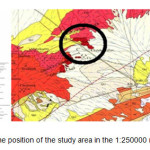
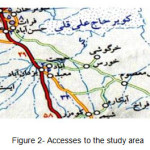
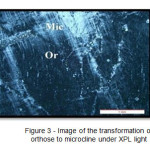
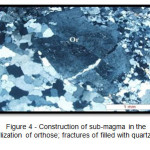
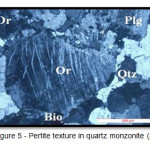
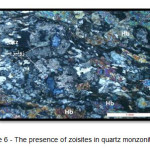
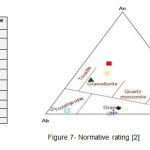
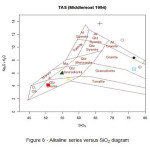
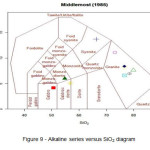
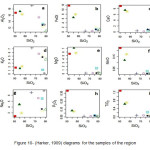
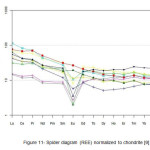
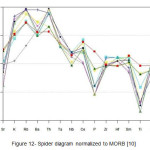
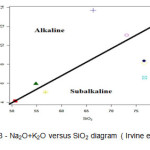
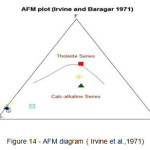
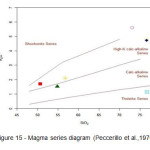
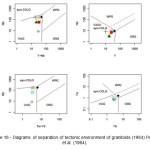

 پاسخ با نقل قول
پاسخ با نقل قول

علاقه مندی ها (Bookmarks)